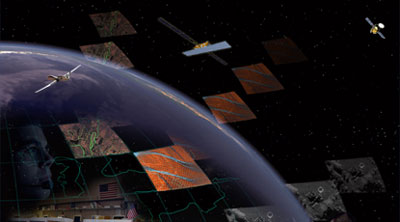Solar power satellites and space radarby Taylor Dinerman
|
| Such large arrays would make the SR spacecraft easy targets for enemy antisatellite weapons and would also produce so much drag while in LEO that their lifespan would be shorter—perhaps much shorter—than current-generation reconnaissance satellites. |
Why, then, does such a system need to rely 100% on its own power? If solar power satellites (SPS) were available in geosynchronous orbit and could beam electricity to the SR satellites in LEO, this might allow the radar satellites to have as much power as their power control systems and heat radiators could handle. Power could be transmitted by a tightly focused laser or microwave beam to one or two receptors, integrated into the spacecraft’s bus. If the radar antenna were integrated into the skin of the satellite the way it is on a B-2 bomber, such satellite would be difficult to detect and track.
Using power from an SPS, such a satellite would be able to liberally use its ion engines to change its orbit. These engines would never be powerful enough to make the kind of quick responsive maneuvers that some space operations commanders would like to see in future LEO-based spacecraft, but they would be a step in the right direction.
The demise of the E-10 program that had been intended to replace the Air Force’s JSTARS and AWACS surveillance aircraft has left a hole in future US situational awareness capabilities that neither unmanned aerial vehicles (UAVs), such as the Predator and Global Hawk, nor existing satellite programs can possibly fill. Space Radar could do so, but only if the program is restructured to make it at once more ambitious in terms of future capability and less ambitious in terms of near-term operations.
The first steps in such a program would be to begin work on an experiment to prove that power transmission in space via laser is possible. Already lasers are being used for communications in civil and military applications; taking this one step beyond to encompass power should be within the state of the art. At the same time the US Defense Department and NASA could begin joint work on a new generation of high-capacity power systems for future spacecraft. The power management and thermal control needs of a spacecraft that will carry a human crew to Mars may not be all that different from those of an SPS or an SR satellite.
The bulk of the development work on the radars themselves can be left until later in the program. Meanwhile, the US could profitably study less ambitious space radar programs such as Canada’s Radarsat. Launching one or two modest technology development satellites over the next five or ten years would be a helpful way to set the stage for a new SR program. In the long term, say, by around 2010, the GMTI radar could be replaced and supplemented by an Air Moving Target Indicator (AMTI), which would need even more power.
Instead of using a single large antenna or multiple smaller ones on the same spacecraft, a future stealthy SR could use radars on multiple satellites. Formation flying is now commonplace and coordinating multiple beams from two or three satellites in different orbits should not be that hard. The biggest problem will be to prove to Congress that the technology is ready for prime time.
Almost all of America’s major military space programs are too far along to effectively incorporate the lessons of China’s ASAT test. SR, due to repeated budget cuts, is the great exception. Other satellite programs that could be modified to incorporate the needs of the new space warfare requirements include the T-SAT Transformational Communications project and the possibly the NRO’s problem-plagued Future Imagery Architecture (FIA).
| If the US were to develop space solar power for military applications it would give the US civilian industry a big head start. As long as the military requirements are legitimate, there is no reason why this cannot be made into a win-win outcome. |
The stealthiness and robustness of all these programs, or their successors, would benefit from being able to draw electricity from a set of SPSs in GEO. The solar power satellites themselves would not necessarily have to be owned by the US government. They could be built privately based on a contract that promises that the Defense Department would buy a given amount of power at a predetermined price. This would be similar to the “power by the hour” contracts that are sometimes signed with jet engine manufacturers or the privately-financed initiative that the British RAF has established with a consortium for a new squadron of Airbus refueling tanker aircraft.
In GEO an SPS is a large and conspicuous target. A realistic new space architecture would have to find ways to give both active and passive protection to such valuable assets. At the same time, these measures must not detract from the commercial profitability of the operation. The Civil Reserve Air Fleet system is a possible model; airlines buy some planes that are modified for possible military use in an emergency and the government compensates them for the extra weight they carry while in normal commercial use.
Space solar power is, in the long run, inevitable. The Earth’s economy is going to need so much extra power over the next few decades that every new system that can be shown to be viable will be developed. If the US were to develop space solar power for military applications it would give the US civilian industry a big head start. As long as the military requirements are legitimate, there is no reason why this cannot be made into a win-win outcome.
